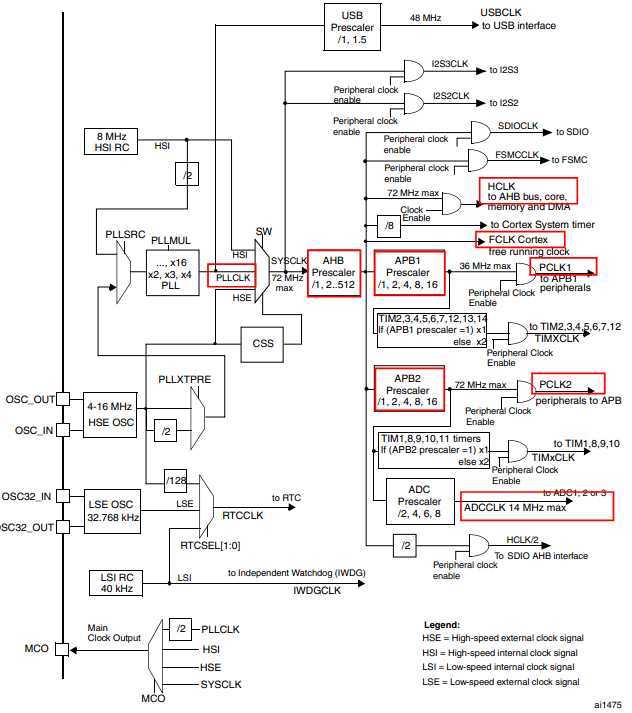标签:style blog class code tar color
一、时钟树

STM32有4个时钟源:
1)HSE(高速外部时钟源) 外部晶振作为时钟源,范围为4~16MHz,常取为8MHz
2)HSI(高速内部时钟源) 由内部RC振荡器产生,频率为8MHz,但不稳定
3)LSE(低速外部时钟) 以外部晶振作为时钟源,主要供给实时时钟模块,一般用32.768KHz。
4)LSI(低速内部时钟) 由内部RC振荡器产生,也是提供给实时时钟模块,频率约为40KHz。
二、系统启动过程中时钟设置
以使用STM32库函数SystemInit为例进行说明:
上电后:默认使用HSI
SystemInit: 倘若调用了函数SetSysClockTo72,将启用外部晶振HSE,并将系统时钟设置到72MHz。
附SetSysClockTo72函数代码:

/** * @brief Sets System clock frequency to 72MHz and configure HCLK, PCLK2 * and PCLK1 prescalers. * @note This function should be used only after reset. * @param None * @retval None */ static void SetSysClockTo72(void) { __IO uint32_t StartUpCounter = 0, HSEStatus = 0; /* SYSCLK, HCLK, PCLK2 and PCLK1 configuration ---------------------------*/ /* Enable HSE */ RCC->CR |= ((uint32_t)RCC_CR_HSEON); /* Wait till HSE is ready and if Time out is reached exit */ do { HSEStatus = RCC->CR & RCC_CR_HSERDY; StartUpCounter++; } while((HSEStatus == 0) && (StartUpCounter != HSE_STARTUP_TIMEOUT)); if ((RCC->CR & RCC_CR_HSERDY) != RESET) { HSEStatus = (uint32_t)0x01; } else { HSEStatus = (uint32_t)0x00; } if (HSEStatus == (uint32_t)0x01) { /* Enable Prefetch Buffer */ FLASH->ACR |= FLASH_ACR_PRFTBE; /* Flash 2 wait state */ FLASH->ACR &= (uint32_t)((uint32_t)~FLASH_ACR_LATENCY); FLASH->ACR |= (uint32_t)FLASH_ACR_LATENCY_2; /* HCLK = SYSCLK */ RCC->CFGR |= (uint32_t)RCC_CFGR_HPRE_DIV1; /* PCLK2 = HCLK */ RCC->CFGR |= (uint32_t)RCC_CFGR_PPRE2_DIV1; /* PCLK1 = HCLK */ RCC->CFGR |= (uint32_t)RCC_CFGR_PPRE1_DIV2; #ifdef STM32F10X_CL /* Configure PLLs ------------------------------------------------------*/ /* PLL2 configuration: PLL2CLK = (HSE / 5) * 8 = 40 MHz */ /* PREDIV1 configuration: PREDIV1CLK = PLL2 / 5 = 8 MHz */ RCC->CFGR2 &= (uint32_t)~(RCC_CFGR2_PREDIV2 | RCC_CFGR2_PLL2MUL | RCC_CFGR2_PREDIV1 | RCC_CFGR2_PREDIV1SRC); RCC->CFGR2 |= (uint32_t)(RCC_CFGR2_PREDIV2_DIV5 | RCC_CFGR2_PLL2MUL8 | RCC_CFGR2_PREDIV1SRC_PLL2 | RCC_CFGR2_PREDIV1_DIV5); /* Enable PLL2 */ RCC->CR |= RCC_CR_PLL2ON; /* Wait till PLL2 is ready */ while((RCC->CR & RCC_CR_PLL2RDY) == 0) { } /* PLL configuration: PLLCLK = PREDIV1 * 9 = 72 MHz */ RCC->CFGR &= (uint32_t)~(RCC_CFGR_PLLXTPRE | RCC_CFGR_PLLSRC | RCC_CFGR_PLLMULL); RCC->CFGR |= (uint32_t)(RCC_CFGR_PLLXTPRE_PREDIV1 | RCC_CFGR_PLLSRC_PREDIV1 | RCC_CFGR_PLLMULL9); #else /* PLL configuration: PLLCLK = HSE * 9 = 72 MHz */ RCC->CFGR &= (uint32_t)((uint32_t)~(RCC_CFGR_PLLSRC | RCC_CFGR_PLLXTPRE | RCC_CFGR_PLLMULL)); RCC->CFGR |= (uint32_t)(RCC_CFGR_PLLSRC_HSE | RCC_CFGR_PLLMULL9); #endif /* STM32F10X_CL */ /* Enable PLL */ RCC->CR |= RCC_CR_PLLON; /* Wait till PLL is ready */ while((RCC->CR & RCC_CR_PLLRDY) == 0) { } /* Select PLL as system clock source */ RCC->CFGR &= (uint32_t)((uint32_t)~(RCC_CFGR_SW)); RCC->CFGR |= (uint32_t)RCC_CFGR_SW_PLL; /* Wait till PLL is used as system clock source */ while ((RCC->CFGR & (uint32_t)RCC_CFGR_SWS) != (uint32_t)0x08) { } } else { /* If HSE fails to start-up, the application will have wrong clock configuration. User can add here some code to deal with this error */ } }
标签:style blog class code tar color
原文地址:http://www.cnblogs.com/amanlikethis/p/3720724.html